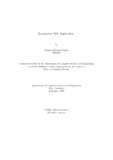| dc.description.abstract | ECommerce is the term used to describe the selling of products and services online.
It’s one of the most dynamic industries in the world, and it’s growing faster than ever
in the past few years. In 2016, ecommerce sales reached $521.6 billion worldwide.
Many people believe that ecommerce will soon surpass traditional banking as the
number one way for businesses to make money. That’s because ecommerce sites can
offer a lot of advantages over traditional methods of selling products. The COVID 19 issue is accelerating the growth of e-commerce towards new industries, customers,
and product categories. This might mean that over time, e-commerce transactions
will change from being for luxuries to being for necessities [2].
Since I had the option to work on any project for my internship final, I decided to
choose ecommerce website development for the aforementioned reasons. I developed
my python development skills while working in the industry, therefore I decided to
complete the project using Django, a python-based web development framework.
And because the back-end programming was my main area of focus, I largely used
HTML and CSS for front-end development.
Since I had not yet developed a website, the process was undoubtedly tough. As a
result, I had to master a range of new technologies, including DRY (Don’t Repeat
Yourself)[1], creating website structures, and learning new languages like HTML
and CSS.
I have acquired a variety of different skills throughout the course of my career,
including team leadership, communication, and appropriate research techniques for
problem-solving. The use of a templating language like Jinja2 and knowing which
functions to use with what is an example of a hurdle I encountered while developing.
Additionally, installing libraries and dependencies presented many difficulties. I had
to manually install many libraries or store them in my project folder in order for it
to work because I couldn’t install them using the command prompt. However, when
I encountered more difficulties, it took me less time to find a solution. As a result,
from my perspective, I would strongly advise students like me to take part in these
kinds of real-world projects rather than solely depending on textual or academic
knowledge. He or she will be able to learn a lot during this procedure. | en_US |

